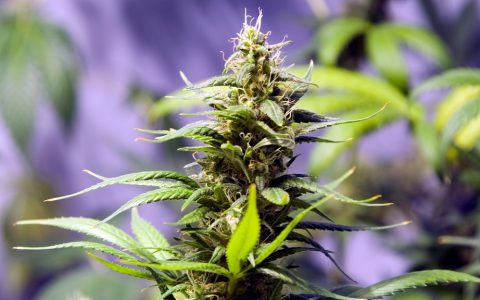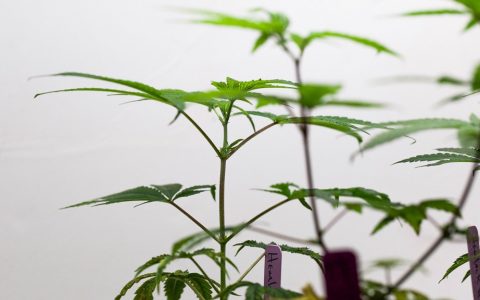Cannabis 101 | Cannabis education and information on ways to consume, how to grow or harvest, and more.
The secret to growing great cannabis isn’t really a secret at all; provide your plants with adequate light, a suitable climate, the right amount of water, and proper nutrients, and you will have healthy plants capable of fighting off most pests and diseases.
When plants do not receive the correct level of nutrients, they become stressed and more susceptible to bugs, mold, and other pathogens. Their growth may also be stunted, resulting in reduced yields. Knowing the signs of nutrient deficiency is a vital skill for budding cannabis growers, so let’s take a look at all the essential nutrients, the symptoms associated with their absence, as well as other factors in potential deficiencies.
Getting the Right pH for Your Cannabis Plants

Plants can only absorb nutrients through their roots if the growth medium or hydroponic solution is at the correct pH. If conditions are too acidic or too alkaline, certain nutrients become unavailable to the root system. Over-fertilizing your plants can quickly lead to pH problems and nutrient lockout, showing symptoms that are easily mistaken for a nutrient deficiency to the untrained eye.
Before attempting to diagnose any nutrient deficiency, be sure that the pH of your soil, medium, or hydroponic solution is within the acceptable range. For soil and soil-like media, the range is 5.8 to 6.8, with 6.3 considered optimum. The proper range for hydroponic solutions is 5.5 to 6.5, and most brands of hydroponic nutrients will indicate an ideal level for their product. Testing the pH of your water is also recommended, as it can vary widely depending on the source.
“Mobile” and “Immobile” Nutrients

Nutrients are classified as mobile or immobile depending on whether they can be translocated once they have been fully assimilated by the plant. A mobile nutrient stored in the older leaves of the plant can be moved to solve a deficiency in another part of the plant. Immobile nutrients will remain very close to where they were initially deposited.
Mobile nutrient deficiencies will show symptoms in the older leaves at the base of the plant, while immobile nutrients will show the first signs of deficiency in the newer growth at the top and outer branches of the plant. Knowing which nutrients are mobile and which are immobile will help you diagnose potential deficiencies.
Essential Nutrients and Symptoms of Deficiency

Your plant needs several essential nutrients, so be sure to keep an eye on these signs and visual cues that could indicate a potential deficiency.
Nitrogen (Mobile)
The most common nutrient deficiency in cannabis, nitrogen is essential throughout the lifecycle of the plant, but especially during vegetative growth.
Deficiency Symptoms:
- An overall lightening and then yellowing in older, mature leaves, especially near the base of the plant
- Severe deficiency will see continued yellowing, progressing up the plant, with possible discoloration and brown spots at leaf margins; eventually leaves curl and drop
- Decreased bud sites and earlier flowering with substantially reduced yields
Phosphorous (Mobile)
Phosphorous is essential for photosynthesis and the release of stored energy in carbohydrates. While deficiency is uncommon (usually developing due to pH being above 7.0), the result can be catastrophic for young plants, and lead to stunted growth, delayed flowering, low yields, and poor resin production in mature plants.
Deficiency Symptoms:
- Purpling of the petioles (leaf stems) on older leaves, followed by leaves taking on a dark blue-green hue
- As deficiency progresses, both upward and outward growth slows drastically, blackish-purple or dark copper colored spots appear on leaves, and dead spots develop on petioles while leaves curl and drop
- Sometimes leaves turn metallic purple or dark bronze in color
Potassium (Mobile)
Crucial to the production and movement of sugars and carbohydrates, potassium is also indispensable to the process of cell division as well as transpiration, root growth, and water uptake. Simply put, without it plants can’t grow. Deficiency leads to increased internal temperatures in the foliage of the plant, which causes the plant to evaporate more moisture through its leaves to cool down.
Deficiency Symptoms:
- Dull, overly green leaves, followed by “burnt” rusty-brown leaf tips, chlorosis (yellowing), and brown spots, particularly on older leaves
- Further deficiency shows in leaf burn, dehydration, and curling of younger growth
- Left unchecked, potassium deficiency will result in weak plants, high susceptibility to pests and disease, and drastically reduced flowering
Calcium (Immobile)
Essential to cell integrity and growth, calcium aids the flow of nitrogen and sugars through the plant. Deficiency is usually found in hydroponic gardens or outdoors in very wet, cool climates with acidic soil.
Deficiency Symptoms:
- Lower leaves curl and distort, followed by irregular brownish-yellow spots with brown borders that grow over time
- Root tips will start to wither and die, and the plant will become stunted with decreased yields
Magnesium (Mobile)
Magnesium is the central atom in every molecule of chlorophyll, meaning that plants use it in very high amounts. It is crucial for absorbing energy from light, as well as helping enzymes create the carbohydrates and sugars that produce flowers.
Deficiency Symptoms:
- Plants will not show signs of a magnesium deficiency until 3 to 6 weeks after it has begun, at which point you’ll see the areas between the veins of older leaves turn yellow (interveinal chlorosis) and the formation of rust colored spots
- These symptoms will progress through the whole plant, with more and larger spots developing in the interveinal areas as well as tips and margins of leaves
- Some leaves will curl, die, and drop, while the whole plant looks sickly and droopy
- Symptoms of magnesium deficiency will quickly escalate during flowering, leading to a reduced harvest
Sulfur (Semi-Mobile)
Essential to plant respiration and the synthesis and breakdown of fatty acids, sulfur plays a huge part in the production of oils and terpenes. It is uncommon to see a sulfur deficiency in cannabis, but these deficiencies are usually the result of a loss of phosphorous due to a high pH level in the root zone.
Deficiency Symptoms:
- Look for young leaves to turn lime green then yellow with stunted growth, followed by the yellowing of leaf veins accompanied with drying and brittleness
- Continued deficiency results in slow, weak flower production with lowered potency
Copper (Semi-Mobile)
Needed only in trace amounts, copper aids in nitrogen fixation, carbohydrate metabolism, and oxygen reduction.
Deficiency Symptoms:
- Deficiency is very rare, and first symptoms are seen in the slow wilting, twisting, and turning of new growth
- Dead spots appear on leaf tips and margins, and sometimes the whole plant wilts
Iron (Semi-Mobile)
Iron is essential for nitrate and sulfate reduction and assimilation, and a catalyst for chlorophyll production. Deficiencies are usually the result of improper pH levels or excess levels of manganese, zinc, or copper.
Deficiency Symptoms:
- Initial symptoms appear in younger growth, with interveinal chlorosis showing at the base of new leaves
- Symptoms then progress through the leaves and into older growth, with overall yellowing between leaf veins
Manganese (Immobile)
Manganese helps utilize nitrogen and iron in chlorophyll production as well as aiding in oxygen reduction. Deficiency is rare and usually caused by high pH or an excess of iron.
Deficiency Symptoms:
- As with other immobile nutrients, symptoms start in the new growth, initially showing interveinal chlorosis followed by necrotic spots, gradually spreading to older leaves
- The most obvious sign is when leaf margins and veins remain green around the yellowing of the interveinal areas
Molybdenum (Mobile)
A player in two major enzyme systems that convert nitrate to ammonium, molybdenum is used by cannabis in very small amounts. Deficiencies are rare and can occur as the result of cold weather.
Deficiency Symptoms:
- Older leaves yellow, sometimes developing interveinal chlorosis and discoloration at leaf edges
- Eventually leaves cup and curl up before twisting, dying, and dropping

Zinc (Immobile)
Zinc is crucial for sugar and protein production, as well as in the formation and retention of chlorophyll and for healthy stem growth. Deficiency is quite common, especially in alkaline soils and dry climates, and is usually the result of high pH levels.
Deficiency Symptoms:
- Young leaves and new growth exhibit interveinal chlorosis, with small, thin leaf blades that wrinkle and distort
- Leaf tips will discolor and burn, followed by leaf margins and then brown spots
- The most obvious sign is leaves that turn 90 degrees sideways



By submitting this form, you will be subscribed to news and promotional emails from Leafly and you agree to Leafly's Terms of Service and Privacy Policy. You can unsubscribe from Leafly email messages anytime.
The post Diagnosing Nutrient Deficiencies in Sick Cannabis Plants appeared first on Leafly.
from
https://www.leafly.com/news/cannabis-101/sick-cannabis-plant-nutrient-deficiencies/













No comments:
Post a Comment